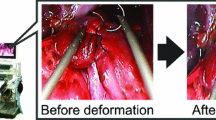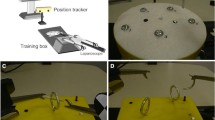Abstract
Purpose
The current state-of-the-art surgical robotic systems use only a single endoscope to view the surgical field. Research has been conducted to introduce additional cameras to the surgical system, giving rise to new camera angles that cannot be achieved using the endoscope alone. While this additional visualization certainly aids in surgical performance, current systems lack visual-motor compatibility with respect to the additional camera views. We propose a new system that overcomes this limitation.
Methods
In this paper, we introduce a novel design of an additional “pickup” camera that can be integrated into the da Vinci Surgical System. We also introduce a solution to work comfortably in the various arbitrary views this camera provides by eliminating visual-motor misalignment. This is done by changing the working frame of the surgical instruments to work with respect to the coordinate system at the “pickup” camera instead of the endoscope.
Results
Human user trials (\(N=14\)) were conducted to evaluate the effect of visual-motor alignment with respect to the “pickup” camera on surgical performance. An inanimate surgical peg transfer task from the validated Fundamentals of Laparoscopic Surgery (FLS) Training Curriculum was used, and an improvement of 73% in task completion time and 80% in accuracy was observed with the visual-motor alignment over the case without it.
Conclusion
Our study shows that there is a requirement to achieve visual-motor alignment when utilizing views from external cameras in current clinical surgical robotics setups. We introduce a complete system that provides additional camera views with visual-motor aligned control. Such a system would be useful in existing surgical procedures and could also impact surgical planning and navigation.







Similar content being viewed by others
References
Adhami L, Coste-Manière È (2003) Optimal planning for minimally invasive surgical robots. IEEE Trans Robot Autom 19(5):854–863
Castro CA, Smith S, Alqassis A, Ketterl T, Sun Y, Ross S, Rosemurgy A, Savage PP, Gitlin RD (2012) Marvel: a wireless miniature anchored robotic videoscope for expedited laparoscopy. In: IEEE international conference on robotics and automation, pp 2926–2931. IEEE
Davol P, Sumfest J, Rukstalis D (2006) Robotic-assisted laparoscopic retroperitoneal lymph node dissection. Urology 67(1):199-e7
Faul F, Erdfelder E, Lang AG, Buchner A (2007) G*power 3: a flexible statistical power analysis program for the social, behavioral, and biomedical sciences. Behav Res Methods 39(2):175–191
Hart SG, Staveland LE (1988) Development of NASA-TLX (task load index): results of empirical and theoretical research. In: Advances in psychology, vol 52. Elsevier, Amsterdam, pp 139–183
Hu T, Allen PK, Hogle NJ, Fowler DL (2009) Insertable surgical imaging device with pan, tilt, zoom, and lighting. Int J Robot Res 28(10):1373–1386
Kazanzides P, Chen Z, Deguet A, Fischer GS, Taylor RH, DiMaio SP (2014) An open-source research kit for the da Vinci surgical system. In: IEEE international conference on robotics and automation (ICRA), Hong Kong, pp 6434–6439
Kim LH, Bargar C, Che Y, Okamura AM (2015) Effects of master-slave tool misalignment in a teleoperated surgical robot. In: IEEE international conference on robotics and automation (ICRA), pp 5364–5370
Macedo JA, Kaber DB, Endsley MR, Powanusorn P, Myung S (1998) The effect of automated compensation for incongruent axes on teleoperator performance. Hum Factors 40(4):541–553
Menon M, Hemal A, Tewari A, Shrivastava A, Shoma A, El-Tabey N, Shaaban A, Abol-Enein H, Ghoneim M (2003) Nerve-sparing robot-assisted radical cystoprostatectomy and urinary diversion. BJU Int 92(3):232–236
Peters JH, Fried GM, Swanstrom LL, Soper NJ, Sillin LF, Schirmer B, Hoffman K (2004) Development and validation of a comprehensive program of education and assessment of the basic fundamentals of laparoscopic surgery. Surgery 135(1):21–27
Pruthi RS, Nix J, McRackan D, Hickerson A, Nielsen ME, Raynor M, Wallen EM (2010) Robotic-assisted laparoscopic intracorporeal urinary diversion. Eur Urol 57(6):1013–1021
Schneider C, Guerrero J, Nguan C, Rohling R, Salcudean S (2011) Intra-operative pick-up ultrasound for robot assisted surgery with vessel extraction and registration: a feasibility study. In: International conference on information processing in computer-assisted interventions (IPCAI), pp 122–132
Simi M, Sardi G, Valdastri P, Menciassi A, Dario P (2011) Magnetic levitation camera robot for endoscopic surgery. In: IEEE international conference on robotics and automation robotics and automation (ICRA), pp 5279–5284
Sukumar S, Rogers CG (2011) Robotic partial nephrectomy: surgical technique. BJU Int 108(6b):942–947
Velasquez CA, King HH, Hannaford B, Yoon WJ (2012) Development of a flexible imaging probe integrated to a surgical telerobot system: preliminary remote control test and probe design. In: 4th IEEE RAS EMBS international conference on biomedical robotics and biomechatronics (BioRob), pp 894–898
Velasquez CA, Navkar NV, Alsaied A, Balakrishnan S, Abinahed J, Al-Ansari AA, Yoon WJ (2016) Preliminary design of an actuated imaging probe for generation of additional visual cues in a robotic surgery. Surg Endosc 30(6):2641–2648
Weber PA, Merola S, Wasielewski A, Ballantyne GH (2002) Telerobotic-assisted laparoscopic right and sigmoid colectomies for benign disease. Dis Colon Rectum 45(12):1689–1696
Worringham CJ, Beringer DB (1989) Operator orientation and compatibility in visual-motor task performance. Ergonomics 32(4):387–399
Acknowledgements
Funding for this work has been provided by the Canadian Foundation for Innovation, the National Science and Engineering Research Council, and the C.A. Laszlo Chair held by Professor Salcudean. The authors would also like to thank Keith Tsang, Irene Tong, Megha Kalia, Neerav Patel, Dr. Peter Black, and Dr. Chris Nguan for their invaluable input and assistance.
Author information
Authors and Affiliations
Corresponding author
Ethics declarations
Conflict of interest
The authors declare that they have no conflict of interest.
Ethical approval
All procedures performed in studies involving human participants were in accordance with the ethical standards of the institutional and/or national research committee and with the 1964 Declaration of Helsinki and its later amendments or comparable ethical standards.
Informed consent
Informed consent was obtained from all individual participants included in the study.
Additional information
Publisher's Note
Springer Nature remains neutral with regard to jurisdictional claims in published maps and institutional affiliations.
Rights and permissions
About this article
Cite this article
Avinash, A., Abdelaal, A.E., Mathur, P. et al. A “pickup” stereoscopic camera with visual-motor aligned control for the da Vinci surgical system: a preliminary study. Int J CARS 14, 1197–1206 (2019). https://doi.org/10.1007/s11548-019-01955-9
Received:
Accepted:
Published:
Issue Date:
DOI: https://doi.org/10.1007/s11548-019-01955-9




